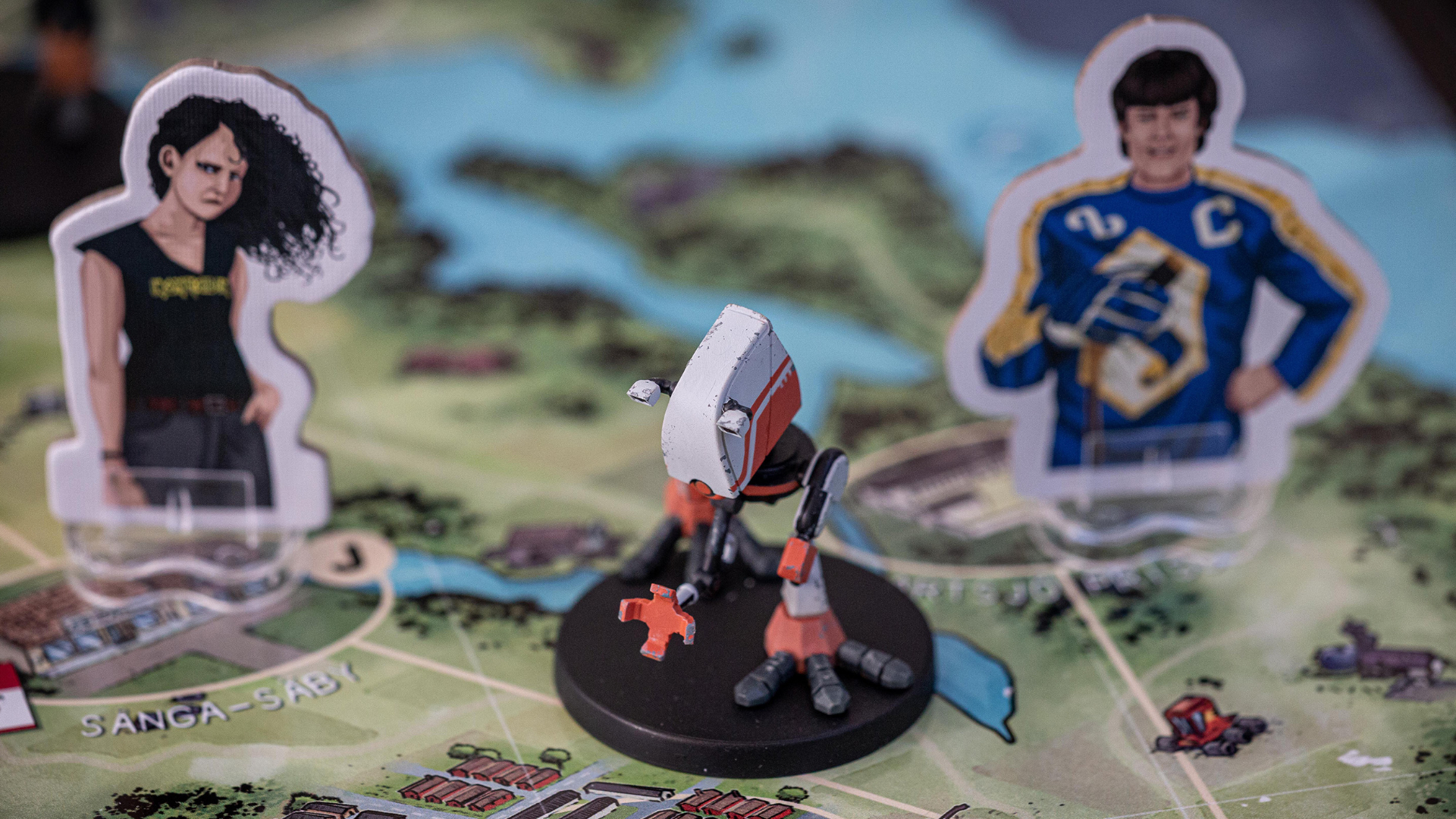GamesRadar+ Verdict
In spite of a compelling mystery, some clunky mechanics and repetitive gameplay let down Tales From the Loop - The Board Game.
Pros
- +
Slow-burn scenario plots that feel like a real mystery
- +
Novel integration of real-world and sci-fi elements offer a fun narrative
Cons
- -
Repetitive core gameplay loop
- -
Clunky maintenance overhead each turn
- -
Poorly written rules
Why you can trust GamesRadar+
November 3, 2025: This review was originally published in 2022, but has since been updated to match our current format with clearer sections and more bitesize breakdowns.
There’s something very enticing about the mix of nostalgia and sci-fi that Tales From the Loop taps into. Simon Stålenhag’s art book, with its mix of towering robots and teenage rebellions, evokes it with enough power that it’s spawned multiple media spin-offs. That now includes a board game where you can solve your very own Stranger Things-like mystery on your tabletop.
The Loop itself is a particle accelerator built beneath an ordinary slice of '80s Swedish suburbia where people raise families and kids go to school. But all is not what it seems: The Loop causes odd things to happen in the area and the players, cooperating as curious teens, need to slip away from parental supervision and find out what’s going on. So, is it one of the best board games for fans of team games?
Tales From the Loop - The Board Game features & design
Price | $74 / £71.99 |
Ages | 14+ |
Game type | Cooperative/narrative/campaign |
Players | 1-5 |
Lasts | 30mins |
Complexity | Moderate |
Designers | Rickard Antroia, Martin Takaichi |
Publisher | Free League |
Play if you enjoy | Kids on Bikes, Betrayal at House on the Hill, The Electric State Roleplaying Game |
- Focuses on solving puzzles
- Stranger Things-style story of kids solving mysteries
- 'Push' rolls for success at a cost
Each mystery in Tales From the Loop is represented by a scenario. There are eight in the base game, and once you’ve solved them all, you can buy additional scenario packs. What scenario you pick will influence how you set up the board as well as give you some narrative text and a starting goal. You won’t know how to win until you’ve worked together to unpeel several more layers of the puzzle.
Players also pick a kid each, with a different strength, weakness, and starting item. As well as delving into the terrors of the cosmos, your kid will also have to contend with a weekly chore to complete and occasional school assignments. The juxtaposition of Scooby-Doo style sleuthing and the humdrum demands of everyday life make a great narrative mix.
Mechanically, movement is interesting with normal movement being point to point. You’ll have a stock of action cubes per day which you can use to move around the island by foot, bus, or, if you’ve been doing your chores, parental lifts. This allows you to look into rumours of strange goings-on. But beware: your cubes are reduced if you get hurt or scared. It's also worth pointing out that the board is overlaid with a grid used by antagonists that permits faster movement.

Enemies in the game mostly take the form of robots that have, for one reason or another, gone amok. But they’re still robots, and that means if you can approach them safely and hack them, you can hitch a ride and use the grid to visit farther-flung locales. While this two-tier movement system adds an interesting layer of strategy, in practice it can be quite confusing to read the board correctly and plot your moves.
If you don’t investigate rumor cards, which are drawn at random into various board locales, they’ll pile up and cause you to lose. Rumors often help you unlock the mystery too, so checking them out is a good idea.
Weekly digests, tales from the communities you love, and more
Doing so, like most things in the game (including robot hacking), requires a series of dice rolls. These are modified by your items, strengths, and weaknesses, and you're looking for sixes to succeed. If you fail, you can "push" the task, risking injury to get a reroll. You can also spend an extra action cube to scout out a robot or rumour first, so you can prepare for what’s coming. It gives a little bit of extra decision-making to what’s otherwise a rather random, repetitive process.
This is also exactly the kind of system publisher Free League has become known for in its roleplaying games (which are arguably some of the best tabletop RPGs around), so it's nice to see here.
Gameplay

- Mysteries are fantastic...
- ...but this reduces replay value
- Rules don't cover edge-cases or omissions
From the rules summary, you have hopefully gotten a general sense of the shape of the game. Unfortunately, that’s probably all you’ll have after reading the rulebook too. While the broad mechanics are clear enough, as soon as you dive in and start playing, you’ll find a wealth of omissions and edge cases that aren’t covered. A careful flick through the included player aid and online playthrough videos from the publisher will make things clear, but it’s startling that a premium-price game like this can’t explain it in the first place.
When things do start to come together, the standout concept in the game is the branching scenario path. It’s been done before but rarely so well as here, combining well with the drudgery of school and home life to create an engaging slice of sci-fi '80s life. Not knowing your final goal might feel frustrating at first, but it soon leans into a delicious sense of mystery as your objectives begin to fall into place one by one. However, at the same time, it does lessen the replay value of each scenario, even if you fail.
And failure is a very real option. Getting around much further than your hometown, the local shops, and the school with your measly allowance of action cubes is difficult. Hitching lifts on robots and solving rumours often requires two players to help each other with the tasks, meaning they have to be in the same locale. At the same time, the demands of chores, school, and home life will push players in their own individual directions. Getting the balance right as the time ticks down and robots rampage around the map is the meat of the game, and it’s a fun challenge.

This game is based on the art of Simon Stålenhag, but it's not the only one in Free League's repertoire. The publisher is also responsible for the excellent The Electric State Roleplaying Game, which we called the "quintessential road trip movie turned TTPRG" in our review.
What’s not so fun is actually seeing if you resolve the challenges as they turn up. Almost all of them use the same mechanic of rolling a pool of dice and looking for a six. You will end up doing this a lot and it gets rather tiresome. Other cooperative games - and many of the best adult board games, for that matter - do use similar systems, but they tend to have a bit more variety in terms of how you build the pool with different stats and one-shot items, not to mention interlacing with other mechanical aspects. Not so in Tales From the Loop.
There’s also a lot of administrative overhead in keeping the game ticking over. Different paths through each scenario mean digging different cards out of the box. It’s the same for the various robot enemies, of which there will be several types in play at once with different behaviour cards you’ll need to keep checking, cross-referencing, and changing. The number of variables helps to keep the game interesting, but it also stops you from learning the routines and getting into a groove, meaning the annoying overhead stays annoying.
Should you buy Tales From the Loop - The Board Game?

With its poor rulebook and clunky play, it’s hard to recommend Tales from the Loop from the wealth of much better team board games on offer. That said, there is a much better game with some fun, novel narrative and strategic elements buried inside the cruft, struggling to get out. If you’re a fan of the wider Loop franchise, it’s probably worth your time and effort trying to dig it free.
Ratings
Criteria | Notes | Score |
|---|---|---|
Game mechanics | Its mysteries and balancing responsibilities with battling robots is compelling, but there's a lot of administrative overhead. | 3/5 |
Accessibility | Although you'll get the basics easily enough, the rules don't cover edge cases or omissions that come up more than you'd think. | 2/5 |
Replayability | Because so much of the game revolves around its mysteries, you won't get as much coming back to the same missions. | 2/5 |
Setup and pack-down | There's a lot to juggle here, and in-game admin is quite full-on. | 2/5 |
Component quality | Whether it's the artwork or intricate tokens, this game looks visually stunning. | 5/5 |
Buy it if...
✅ You love the kids-solve-mysteries trope
If there's anything this game does brilliantly, it's tapping into the Stranger Things-style cliche of kids solving mysteries together.
✅ You want a strong narrative game
Its world and story make this game as compelling as it is. They're the best bits by far.
Don't buy it if...
❌ You want a very replayable game
The game's focus on mysteries means you won't get as much coming back to those missions later on - once they're solved, you know the solution.
❌ You're expecting an intricate strategy game
Tales From the Loop focuses on narrative over complex tactics of the kind you'd see in a game like Scythe.
How we tested Tales From the Loop - The Board Game

This review was conducted using a sample provided by the publisher.
We make a point of tackling a game's rules in their entirety first in all of our tabletop reviews, and it was no different for Tales From the Loop. We then proceeded to run test games, and we played multiple times to get a better sense of how replayable it was.
For a deeper dive into our process, check out how we test board games or the full GamesRadar+ reviews policy.
Want more recommendations? Don't miss the best card games or the best 2-player board games.

Matt is a freelance writer specialising in board games and tabletop. With over a decade of reviews under his belt, he has racked up credits including IGN, Dicebreaker, T3, and The Guardian.
- Benjamin AbbottTabletop & Merch Editor



